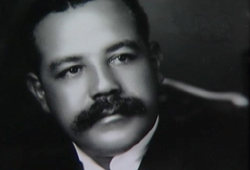Teachers' Domain - Digital Media for the Classroom and Professional Development
User: Preview

Source: The Rise and Fall of Jim Crow: "Fighting Back"
Throughout America’s history there has been a “nativist” component to American society and culture. At its height in the 19th century, many native-born citizens viewed new immigrants and slaves as a threat to American society. This fear of “the other,” or xenophobia, infiltrated the American psyche. Many feared newcomers would introduce foreign practices and languages that would threaten the American way of life. One common tactic has been to target these groups in ways that degrade their culture. Nowhere is this fear and bigotry more evident than in toxic images depicted in the advertising and print cartoons of popular culture.
In the late 19th and early 20th centuries, in an effort to connect with the public, advertisers used common stereotypes and racist attitudes to generate commercial profits. As history shows, the older the advertisement, or image, the more offensive it tends to be, often reflecting the belief systems of the day. For example, a pest-control advertisement from the 1900s featured a Chinese immigrant eating a rat, which referenced the then commonly held myth that people of Chinese origin ate rodents. A campaign highlighting the Mexican “bandito” promoted the notion of the “lawless” Mexican. Today, sports symbols used by the Cleveland Indians and Notre Dame’s Fighting Irish promote a negative representation of Native Americans as crazy warriors and Irish men as hotheaded aggressive leprechauns.
In the end, no stereotypes have been exploited, in print or on screen, more than those held by racist whites towards African Americans. Advertisers have used images of people of color that perpetuate Jim Crow and hark back to a time when white Americans’ view of black culture was shaped by fear, racism and intolerance. Images of “Uncle Ben” and “Aunt Jemima” represent the jovial slave from antebellum years who worked in the kitchen, there to serve white people. Other images of the deviant, sexually aggressive black male were present in films like Birth of a Nation, which glorified the Ku Klux Klan and demonized black men. These images had lasting effects and have helped to sustain racist ideas throughout the Jim Crow period and beyond.
Narrator: As political possibilities were taken away vehicles for self-expression became all the more important in the black community. Many people who could not express themselves politically found that music was a perfect vehicle for doing something individual. A different kind of self-determination, if you will. Taking the rules of 19th century music making, which was all about reading music, and tossing them, and saying, I’m going to do this music my way instead.
Narrator: Jazz burst forth like a trumpet sound. The kings and princes of jazz like Bechet, Jelly Roll Morton, King Oliver and Louis Armstrong would pour forth wave after wave of joyous sound.
Bryan Stevenson: What music did was to challenge the prevailing racial biases, that black people were inferior, that they didn’t have the quality of thought that would ever allow them into a race that would be treated equally. What music did was to challenge that. For here was the enormously creative and quite compelling art form that was evolving that as quite captivating to anyone who heard it, black or white. It gave strength to the idea that people were capable of all kinds of greatness. And it challenged the lie.
Mark Bauerlein: There was over the course of the first years of the 20th century a rising Negrophobia as it was called. A Negro phobic attitude would look at a black individual and only see beneath whatever middle class exterior might be there. Deep down there would be a savage. And only the control, and the discipline, and the surveillance of whites was able to keep that black individual in check.
Kenneth Goings: (Historian) Almost all facets of American society had given in to that notion of racism. History, biology, psychology, sociology, philosophy all talked about African Americans as being inferior, as being not equal, as being not worthy of equal treatment. One of the things that’s happening at the same time is national advertising and all of those things that are being associated with inferiority are being attached to the black race. The message in the image was that African Americans are criminals, were on the edge of criminality. These images are often distorted African Americans, they’re not real human beings. There’s something out of kilter. There’s something not right about them. Large heads, often with big lips, bulging eyes, something’s wrong. All of things are working to make real the notion of African Americans as inferior beings, as an inferior race, as people not like white people, as people separate from them.
 Loading Standards
Loading Standards